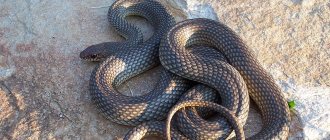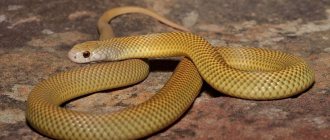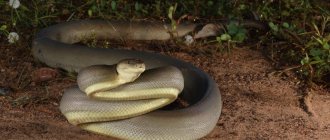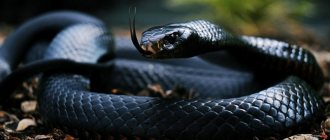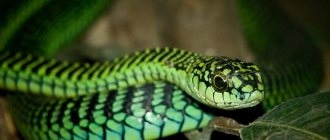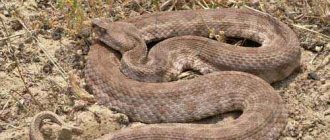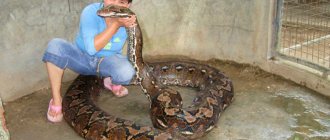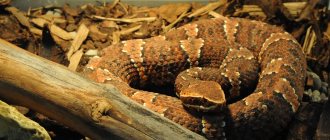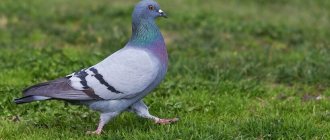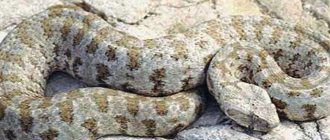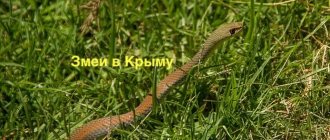- Wild animals
- >>
- Reptiles
The yellow-bellied snake is a common species of non-venomous snake in the south of Russia, belonging to the slender snakes. In some areas it is called the yellow-bellied snake or yellow-bellied snake. These are the largest snakes in the post-Soviet space. Due to its aggressive behavior, yellowbellies are rarely kept in terrariums or as pets. However, the Yellowbelly snake is beneficial to agriculture because it feeds on rodents, which cause significant damage to crops. Due to these benefits, more localized damage from eating birds and their eggs is negligible.
Origin of the species and description
Photo: Yellowbelly snake
The yellow-bellied snake is a large, non-venomous snake from the Colubrid family. In the past, Colubridae were not a natural group, as many of them were more closely related to other groups than to each other. This family has historically been used as a "garbage bin" for various taxa of snakes that do not fit into other groups. However, recent research in the field of molecular phylogenetics has stabilized the classification of "grassroot" snakes, and the family is now defined as a monophyletic clade. Although more research will be required to sort all this out.
Since its original description by Johann Friedrich Gmelin in 1789, the yellow-bellied snake has been known by many names in Europe.
The list of titles is given below:
- C. Caspius Gmelin, 1789;
- C. acontistes Pallas, 1814;
- C. thermis Pallas, 1814;
- C. jugularis caspius, 1984;
- Hierophis caspius, 1988;
- Dolichophis caspius, 2004
This species includes subspecies:
- Dolichophis caspius caspius - from Hungary, Romania, the southeast of the former Yugoslav Republic, Albania, Ukraine, the Republic of Moldova, Bulgaria, Greece, western Turkey, Russia, the Caucasus coast;
- Dolichophis caspius eiselti is from the Greek islands of Rhodes, Karpathos and Kasos in the Aegean Sea.
Most colubrids are not poisonous or have venom that is not harmful to humans.
Is the bite dangerous for humans?
The yellow-bellied snake is very aggressive, but will not attack first unless it is in danger. Most often, such a danger is presented to him by a person who has disturbed the snake, threatening to destroy its home or destroy its offspring. As a rule, having smelled a person, the snake tries to hide.
Important! The yellow-bellied snake is not poisonous and therefore not dangerous to humans.
In the event of an attack, a bite mark or scratch will remain on the victim's body. As a defense, the snake prefers to attack first. It takes a special, terrifying pose, raising the front part of its body, opening its mouth strongly and hissing very loudly. This sudden behavior confuses the enemy, and at this moment the yellow belly may attempt to jump. By pushing off with its tail, the snake can make a jump of 1 meter in length, with its average length being 2 m.
The snake's attack is swift and terrifying, in an attempt to find the most vulnerable spot on the enemy's body. But not only humans can be very frightened by the aggressive yellowbelly. Even large animals, such as horses, often suffer from its actions. It is worth adding that the behavior of a snake does not depend on its age; both young and experienced individuals can demonstrate such a hostile attitude.
Appearance and features
Photo: Yellow-bellied snake in the Rostov region
The yellow-bellied snake reaches a maximum total body length of 2.5 meters, and is considered the largest in Europe, but the usual size is 1.5-2 m. The head is oval, elongated, slightly separated from the neck. The tip of the nose is blunt and rounded. The tongue is very long and relatively thick. The tail is long and thin. The overall ratio of snake length to tail length is 2.6-3.5. The eyes are large and have round pupils. The maxillary teeth are of uneven length, longer at the back of the jaw, the last two teeth often separated from each other by a narrow gap.
Video: Yellowbelly snake
Biometric data in the control study samples showed: total length (head + body + tail) for males - 1160-1840 mm (average 1496.6 mm), for females - 800-1272 mm (average 1065.8 mm). The length of the head and body (from the tip of the snout to the anterior edge of the cloacal slit) in males is 695-1345 mm (on average 1044 mm); in females - 655-977 mm (average 817.6 mm). Tail length: 351-460 mm (average 409.8 mm) in males, 268-295 mm (average 281.4 mm) in females. Head length (from tip to mouth): males - 30 mm, females - 20 mm. The width of the head (measured between the corners of the mouth) is 22-24 mm for males, 12 mm for females.
The yellowbelly is characterized by smooth dorsal scales. Nineteen rows of scales can be found in the midsection of the body, although sometimes there may be seventeen. The dorsal scales have two apical pits on the posterior edge. They are lighter in the center than at the edges. The snake's back is gray-brown and has markings that are characteristic of young snakes, but disappear with age. The ventral side is light yellow or white.
What does it look like
The average body length of this snake is 2 m, but you can find representatives of this species with a length of 2.5 m, and record specimens can exceed this mark. The tail of this giant occupies a third of its entire length. Despite its impressive length, the runner does not look massive, since the diameter of its body is no more than 5 cm.
The snake's head is small, with large scutes. The yellow-bellied has large eyes with a round pupil, the iris of the eyes is orange in color with dark spots. The dorsal part of the runner has no ribs. It has smooth scales, with a slightly pronounced keel along the edge of the ventral scutes.
Find out what the corn snake and Aesculapian snake look like.
The color of the scales of the visible part of the snake’s body is quite varied:
- olive;
- gray;
- brown;
- yellow.
In various combinations and shades they make up a very beautiful composition. The belly of this species of snake, of course, has a yellow color, which is how it got its name. Juveniles have several rows of spots along a gray or brown background on the upper body. These spots merge into small, short stripes located horizontally. There are also rows of small spots on the sides.
Where does the yellowbellied snake live?
Photo: Yellow-bellied snake
The yellow-bellied snake is found on the Balkan Peninsula, in parts of Eastern Europe to the Volga region and in a small part of Asia Minor. It can be found in the open steppe, in steppe and mountain forests, on the edges of steppe forests, in bushes near roads, in semi-deserts, in sand and on slopes, near mountain streams, between bushes covered with vegetation, stones and rocks, on the slopes of valleys and ravines , on steep banks along rivers and dry reeds.
In the North Caucasus, yellowbellies penetrate desert areas with sandy mounds. During dry periods of the year, it is often found near river beds and even in swamps. Often crawls in search of food and places to lay eggs in various ruins, including the ruins of houses, in household outbuildings or even in residential buildings, under haystacks, in gardens, vineyards and other similar places. In the mountains it rises to a height of 2000 m. In the Caucasus it is found at altitudes from 1500 to 1600 m.
Populations of the yellow-bellied snake have been recorded in the following countries:
- Albania;
- Bulgaria;
- Macedonia;
- Serbia;
- Turkey;
- Croatia;
- Greece;
- Romania;
- in the south of Slovakia;
- Moldova;
- Montenegro;
- on the south of Ukraine;
- In Kazakhstan;
- in the south of Russia;
- in the south of Hungary;
- Jordan.
Habitats may be distributed in lowlands near large rivers such as the Danube and the Olt River. Previously, it was assumed that the yellow-bellied snake became extinct in Moldova, eastern Romania and southern Ukraine, where only two habitats were known and the snake had not been observed since 1937. However, three specimens were collected in May 2007 in Galati County in Romania.
In Hungary, the Yellowbelly was previously thought to live in only two areas, but a recent survey of the region has revealed several previously unknown habitats of these snakes along the Danube River. In southern Crimea there is an average of 1 specimen per 2 km², in northern Dagestan - 3-4 snakes per km², and in southern Armenia - on average 1 specimen per 1 km².
Now you know where the yellow-bellied snake lives. Let's see what she eats.
Small but biting steppe viper
As you already understand, this is the only poisonous snake in Crimea. At the same time, over the past 10 years, no deaths after its bite have been recorded on the peninsula, and it is unknown whether any have been recorded at all. For comparison, the victims of spiders, the same karakurt, are found regularly.
The steppe viper (Vipera ursinii) is a relatively small snake, its length rarely exceeds 60 cm, it is smaller than the common one known to everyone. In Crimea, vipers are found not only in steppe areas, but also in forests on the slopes. They are often found on the Kerch Peninsula, gray in color with a dark pattern on the back in the form of a classic zigzag or a series of spots; There is also a dark pattern on the head. The black variety is also common - scientists call such subspecies melanists.
Like all vipers, this venom has a hemolytic effect, that is, it destroys the blood formula and the walls of blood vessels (on this basis it is used to make medicines for thrombophlebitis). If she bites, the affected area hurts, swells, turns red and even turns blue. Sometimes a headache occurs and the temperature rises.
Anti-bite serum exists, but it is not guaranteed to be available at your nearest hospital. It is harmful for the victim to move (then the blood spreads the poison throughout the body more intensely), and the reptile usually attacks far from medical aid points. Therefore, more often than not, help is limited to making the victim comfortable, cooling the damaged part, and taking a large amount of liquid (not alcohol!) and an antipyretic. Symptoms noticeably decrease after a few hours, but then within a couple of weeks bruises appear on the body for no apparent reason.
What does the yellowbelly snake eat?
Photo: Yellow-bellied snake
It feeds mainly on lizards: rock, quick, Crimean and sand. Less commonly, chicks, birds and their eggs. And also rodents: gophers, rats, mice, gerbils, hamsters. Sometimes the diet includes other snakes, including poisonous ones: the common viper and sand ephas, to the poisonous bite of which the yellow-bellied snake is indifferent. The snake rarely feeds on amphibians; in damp areas it catches frogs. Large insects and spiders can also become victims of yellowbellies.
The snake can move through rodent burrows and destroy them. In search of food, it climbs trees, where it devastates the nests of birds that do not settle too high, but most often hunts birds nesting on the ground. In Crimea, the favorite food of snakes is reptiles - lizards, snakes and mammals - gophers, shrews, voles, mice, hamsters.
Interesting fact: In the Astrakhan region, the bad snake in semi-desert regions feeds on sand lizards and fast foot-and-mouth disease (31.5%), sand lizard (22.5%), skylark and crested lark, as well as gray little lark (13.5%), sandwort (9%), ground squirrels (31.7%), gerbils (18.1%), mice (13.5%), hamsters (17.8%) and insects and spiders.
In captivity, young individuals prefer lizards; adults feed well on mice and white rats. This fast and powerful snake captures its prey with amazing speed. The yellow-bellied swallows small prey alive without suffocating it. Larger animals that resist are first killed by pressing on them with a strong body or by grabbing them by the mouth and strangling them by wrapping rings around the victim.
Nutrition
Yellow-bellied snakes have instant reactions, excellent vision, and move quickly - these qualities make them excellent hunters. They pursue their prey so energetically that neither a nimble lizard nor a rodent can escape. The yellowbelly is able to overtake its live food in any hole.
The size of the reptile gives it the opportunity to eat not only small animals, but also swallow whole hamsters, gophers, birds and even its fellows - smaller snakes. They also feed on locusts and mice, they can swallow shrews and frogs, and they destroy bird nests.
The snake hunts in tall trees, waiting for its prey in ambush, maneuvering along the branches, and jumping down after its prey. Even the bite of a viper, which he can sometimes catch and eat, does not cause him much harm. The capture tactics are as follows:
- catch up with prey
- wrap your body in rings and thereby immobilize her,
- enjoy your meal.
High speed of movement almost always ensures successful hunting for the snake.
Features of character and lifestyle
Photo: Yellowbelly snake
The yellow-bellied snake overwinters in rodent burrows and other earthen shelters. Hibernation lasts about six months. For winter rest, more than ten individuals often gather in one place. The yellow belly comes out of its hiding place in late April - early May, and begins to be active in February - March, depending on the area, until September-October. In Crimea and the Northern Caucasus, the snake appears on the surface after hibernation in late March - early April, in the south of Ukraine - in mid-April and in Transcaucasia at the end of February.
The yellow-bellied snake is a diurnal, non-venomous snake that basks in the sun, partially shaded by some bushes, and hides in anticipation of lizards. In spring and autumn, the snake is active during the day, and in summer, during the hottest time of the day, it rests, and is active in the morning and evening. This snake is the fastest in our fauna, slithering at high speeds so that it can barely be seen. The speed of movement allows the yellowbellied to capture even very fast prey.
Interesting Fact: The hallmark of the yellow-bellied snake's bad behavior is its unusual aggression. Among the snakes of our fauna, these snakes (especially males) are the most aggressive and harmful. It does not try to hide when a person approaches, as other snakes do, but curls up in rings, as poisonous vipers do, and throws 1.4-2 m, trying to hit the face.
In forested areas with trees and shrubs, they quickly rise upward until they disappear into the foliage at high altitudes (up to 5-7 m). The same ease is evident when moving among rocks and crevices. Although the yellowbellied snake is a non-venomous snake, the bite of an adult is painful, bleeding, and sometimes infected, but is usually not dangerous to human health.
Hunting tactics and methods
The yellow-bellied snake is a very cunning and dangerous hunter, capable of attacking from an ambush. At the same time, it does not sting its victim, but squeezes it with its rings, like a boa constrictor. This grip can immobilize prey in a matter of seconds. And after the poor fellow who gets caught stops twitching, the snake calmly eats him.
And even if the prey somehow escaped the trap, it has very little chance of escaping from the yellow-bellied snake. Indeed, thanks to his muscles, he is able to develop great speed, with which almost no one is able to compete.
The snake prefers to hunt during the day, since at night its reaction decreases due to the drop in temperature. But if it’s very hot outside, then this tactic can change exactly the opposite.
Social structure and reproduction
Photo: Little Yellowbelly
The yellow belly reaches sexual maturity 3-4 years after birth. At this time, the length of the snake is 65-70 cm. Sexual dimorphism in this species is obvious: adult males are larger than females, their heads are much larger. During mating games, snakes meet in pairs. In the more northern regions of the range, mating occurs at the end of May, and in the southern regions, for example, in Crimea, from mid-April to mid-May.
Fun Fact: The snake's genitals are not on the outside of the body at the base of the tail, as they are hidden in a pocket at the base of the tail called the cloaca, which also houses their liquid and solid waste system. The male's genitalia, the hemipenes, consist of two joined penises, each connected to one testicle, giving it a bifurcated appearance.
The male Yellow-bellied Snake powerfully grabs the female's neck with his jaws and immobilizes her, wrapping his tail around her, and then copulation occurs. During mating, the yellow-bellied snake loses its usual vigilance. Once the snakes finish sexual intercourse, they disperse.
After 4-6 weeks, the female begins to lay eggs in the place chosen the day before. The clutch consists of 5-12 (maximum 20) eggs with an average size of 22 x 45 mm. Eggs are laid in hidden places: in natural cavities in the soil, sometimes in trunks or cracks in tree trunks. Small yellowbellies hatch in the first half of September and reach 22-23 cm (without tail) at hatch. There have been reports of the species breeding in captivity. The lifespan of the yellow belly is 8-10 years.
What to do when meeting a snake?
When encountering a reptile, you must remain calm. In most cases, the snake is trying to elude the person.
If she doesn't go away, you should carefully step back. Absolutely forbidden:
- Watch out for the snake
- Attempting to touch a reptile
- Approaching or leaning towards a snake
- Annoy a representative of scaly animals with sudden movements
To avoid all the unpleasant moments, you can look at a few photos with the snakes of Crimea before your vacation.
Note!
Domestic turtles - the most popular species, cultivation features, tips for care and maintenance (115 photos + video)- Indian snakes: sacred, poisonous, most common and dangerous types of Indian snakes and their names (130 photos)
Small snakes - an overview of popular and rare species, habitats, food and names of snakes (115 photos)
If the snake begins to attack, it should be thrown away and frightened with noisy, dull sounds. There is no need to run away or panic. It is advisable to try to leave the area where the quarrel is occurring.
When a person leaves the snake's place, it gradually calms down. It is important to remember that the scaly representatives of Crimea are not very dangerous. According to research, snakes are much more afraid of humans than humans. Reptiles are very weak and less protected.
Natural enemies of yellowbellied snakes
Photo: Yellow-bellied snake in Russia
The reptile uses cracks in the soil, rodent burrows, holes in piles of stones, rocky formations in steppe valleys, bushes, holes near tree roots and ditches as shelters. When confronted with an enemy or when he approaches, the yellow-bellied snake does not try to hide, fleeing; on the contrary, it takes a threatening pose, twisting into rings and raising the front part of the body like poisonous snakes, furiously flapping its open mouth, rushing furiously at the enemy with long jumps and trying to hit enemy.
Large specimens of snakes can jump at a distance of 1.5-2 m. This intimidating behavior is intended to scare away a potential enemy and creates a respite for the snake to escape. The yellowbell's aggressive behavior can even frighten a large animal, even a horse. If the yellow-bellied snake is caught, it is very aggressive and makes barking sounds while attempting to bite the face or arm of its attacker.
It happens that yellow-bellied snakes become victims of large birds, martens, and foxes. They also die under the wheels of a car: a car is not a horse; it cannot be frightened by loud hissing and threatening jumps.
The parasites of this snake cause harm to the yellowbelly:
- Gamasid mites;
- acanthocephalans;
- leaf fish;
- nematodes;
- trematodes;
- cestodes.
Yellow-bellied snakes are rarely kept in terrariums due to their aggressive behavior.
Habits
The yellow-bellied snake is a diurnal reptile. At night, his reaction becomes much weaker. Character - aggressive, can be the first to attack a person if he senses danger. When attacked, it opens its mouth wide and emits a loud hissing sound. The snake's tail swells, it makes a swift throw towards the enemy and bites in the most vulnerable place. At the same time, having frightened the victim, it does not leave it, but attacks several times in a row. Although not poisonous, the bites of this snake are extremely serious. The yellow-bellied snake is not at all afraid of an enemy who is superior in size and strength to it; the snake rarely retreats. You can tell that a snake is preparing to attack by its posture - the yellow-bellied snake characteristically wriggles in a spiral. Having overtaken a victim larger than itself, it wraps itself around it and squeezes it with its body. Smaller ones are swallowed whole.
But, basically, the aggression of this reptile is caused by the need for protection from an enemy who has invaded its territory. Therefore, most often, when faced with a calmly behaving person on a forest path, she simply peacefully retreats.
Yellow-bellied snakes can be kept at home, like many other types of snakes. The yellowbelly will be restless at first, but will gradually get used to it. Aggression will decrease, there is practically no danger for its owner.
Population and species status
Photo: Yellow-bellied snake
Habitat degradation, destruction and fragmentation, expansion of agricultural and grazing lands, deforestation, tourism and urbanization, use of pesticides and agricultural fertilizers, direct destruction by local residents, illegal collection and road traffic are the main reasons for the decline of the Yellowbellied snake.
The vicious nature of the yellowbelly causes excessive hostility among people. This adds to the public lifestyle and large size and leads to frequent destruction of the snake. Like other inhabitants of plains and open landscapes, the species suffers from various forms of economic activity. Therefore, the number of the yellow-bellied snake is rapidly falling, but the snake is not threatened with extinction in the near future.
Interesting fact: Climate change is one of the most important threats to biodiversity. Organisms such as amphibians and reptiles are especially vulnerable because... climatic conditions have a direct impact on them.
There is little to no data on the conservation status of the yellow-bellied snake in many regions. Although it is known to be common in the Dobruja region, it is a rare species and is endangered in other areas. Roadkill snakes are a “common sight” for locals. Traffic-related deaths may be responsible for the population decline. Habitat loss is responsible for the species' decline in Europe. In Ukraine, the yellow-bellied snake lives in regional landscape parks and customers (in many habitats it is considered a common species).
Unfairly negotiated copperhead
Snakes are often victims of human prejudice. Instead of finding out whether there are dangerous reptiles in a given area by studying their photos and descriptions, people tend to consider them all poisonous and aggressive, destroying them. The most harmless copperhead “fell under attack” so often that it ended up in the Red Book.
The common copperhead (Coronella austriaca) is a relatively small snake (individuals exceeding 80 cm in length are rarely found) and come in a variety of colors. The classic option is a reddish-brown even tone with a metallic tint, brighter on the belly. But there are also grayish, brown, and even black representatives. The main feature is an eye with a transverse line.
The copperhead is absolutely harmless - it has no poison, and its teeth are very small. Large samples often scratch the skin (an injury comparable to the result of the prank of a playful kitten), but this damage will heal in a couple of days without treatment. Young snakes are not at all able to damage human skin. They feed on lizards, and sometimes on chicks and insects.
general information
The yellow-bellied snake is a snake representing the family of colubrids. True, unlike its closest relatives, it is capable of growing to gigantic sizes. There were cases when researchers found individuals whose length exceeded 2 m. Based on this, we can say with confidence that the yellow-bellied snake is the largest snake in Europe.
And besides, you can find it almost all over the continent, including in Russia. The Crimean yellow-bellied snake is especially interesting for scientists. This is due to the fact that there are quite a lot of them on the peninsula. And this allows you to observe snakes in their natural habitat without much effort and expense.
Habits and customs of the yellow-bellied snake
This snake is not picky in choosing its habitat, the main thing is that it has enough warmth and plenty of food. Therefore, you can find its nest both in the open steppe and among mountain ledges. Although she still doesn’t like high altitudes too much, scientists believe that she rarely climbs above 1600 m above sea level.
She builds a nest among empty holes, small recesses, cracks in stones and even in tree hollows. It even happens that she takes the hole of her victim, occupying it along with all the good things. Although, of course, in such cases the former owner most often ends his life in the stomach of the snake.
The snake is not afraid of noise and people, so it can settle next to them. Many eyewitnesses claimed to have seen this careless reptile crawling into their backyard or garden day after day. Although such courage often ended sadly for her, because people do not really like such a neighborhood. And more than a dozen of these snakes have already died under the wheels of cars.
Snake bite - symptoms and first aid
The bite of a poisonous Crimean snake does not pose a serious danger to humans. Yes, it is painful, but almost 100% of people recover on their own within 1-2 days after the attack, even without any specific treatment. Yes, sometimes there are complications after a bite - but in most cases, complications arise due to subsequent improper treatment.
What to do if you are bitten. Video advice from Dr. Komarovsky
In most cases, Crimean vipers are not very aggressive - when they see a person, they immediately crawl away, and they use their poisonous teeth to kill prey. However, in some cases, such a snake can still bite - in case of self-defense and in case of protecting a snake's nest. It should be understood that in case of contact there is no need to tease the snake - do not hit it with a stick, do not pull its tail (it is better not to even try to grab its tail), and so on. If you are bitten by a viper, then you need to do the following:
- The most important thing is don't panic. Yes, the wound may bleed, your head may hurt, and the affected area may become covered with unpleasant spots. But don’t worry, the venom of this snake is very weak and people do not die from it.
- Immediately after the attack, suck out all the poison from the wound, periodically spitting it on the ground. Both the victim himself and other people can suck out the poison. It is advisable that it be suctioned by those people who have no injuries in the oral cavity. However, if the poison gets into the oral cavity, then nothing bad will happen - the poison will easily break down in the stomach and be excreted from the body along with urine.
- The person should be given peace. To do this, find some dark place, lay a blanket on the ground and place a person on it.
- Give him water or some non-alcoholic drink, as alcohol makes the painful symptoms of the bite worse.
- To reduce the likelihood of allergies, give the victim several tablets of diphenhydramine, suprastin or some other antihistamine.
- After providing first aid, the victim must be taken to the hospital.
Leopard handsome Crimean
Some snakes living in Crimea are suspected of being poisonous due to their excessive beauty (it looks like a medieval witch hunt). Among them is the leopard snake (Zamenis situla).
We are talking about a medium-sized (occasionally more than 1.5 m) individual, reminiscent of the “snake print” that has been fashionable in recent years in clothing and haberdashery - this can be seen in the photo. Her body is gray or brown, with bright red or reddish spots surrounded by black. Like everyone else, she can climb branches, but more often she hides on the ground under various shelters (stones, snags). Sometimes they are found in heaps of construction waste (under boards, slate fragments, sheets of tin).
The snake bites, but it is not aggressive or poisonous. Attacks in Crimea usually happen when curious tourists, especially children, try to catch a beautiful, brightly colored snake. They are not dangerous; the wound will heal on its own. The animal itself is in danger - they exterminate it “just in case,” they try to remove its beautiful skin, and catch it to keep it at home. As a result, the animal was included in the Red Book.
By the way, reviews from terrariumists note that this is a wonderful pet if you know how to create suitable conditions for it.
As you can see, the snakes of Crimea do not pose a great danger. Rather, people themselves are dangerous to them - they kill for no reason and try to scare them. But in any case, everyone must remain human. We must remember that you cannot kill snakes without a reason, because they are an important part of natural wealth and complex.
Liked? Share with your friends!
Lifespan and mating season
In general, the yellow-bellied snake can live up to 6-7 years. But few snakes reach this age, as they become victims of natural enemies and unforeseen circumstances. The greatest danger for them are martens and foxes, because for them the snake is a very pleasant treat.
At 3-4 years of life, these reptiles reach sexual maturity and go in search of a suitable mate. They mate at the end of spring, so that the babies probably have time to hatch from the egg and get stronger before the arrival of autumn cold weather. On average, one female produces 5-12 offspring.
In captivity, the snake feels much more comfortable, because here it is deprived of enemies. Therefore, such species are able to live up to 10 years and give birth to many more “heirs” at a time.
